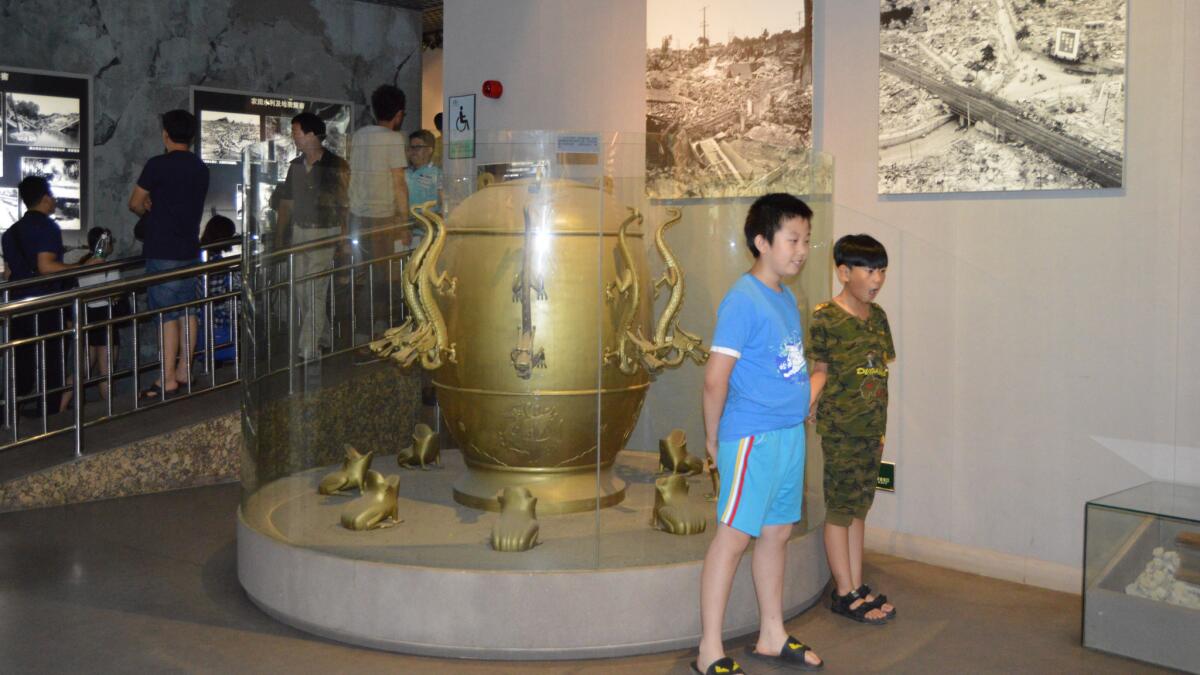40 years after deadly quake, Chinese seismologists trying to figure out when the Big One will strike
- Share via
Reporting from Tangshan, China — At the Tangshan Earthquake Museum, a replica of what is believed to be the world’s first seismoscope stands in stark contrast to haunting images of rubble. The barrel-shaped contraption, nearly 2,000 years old, has a built-in pendulum connected to levers intended to cause a bronze ball to spring toward the direction of a quake.
However, that’s not the only exhibit here that warns visitors of the earth-shaking forces that, 40 years ago this week, flattened this once-booming industrial town 110 miles east of Beijing. The 7.5-magnitude Tangshan earthquake remains the world’s third deadliest, with a death toll exceeding 240,000.

Toward the end of the exhibition is a panel of pictures showing farm animals and panda bears acting strangely, all aimed at educating the public about how to foretell earthquakes.
Since the mid-1970s, Chinese scientists have trained in the West in the latest seismic technology. But one aspect of seismology with Chinese characteristics has endured: the quest to predict quakes — even as seismologists in the rest of the world have deemed it impossible to do with any measure of accuracy.
This was a quest born of a Mao-era ethos and Cold War politics.
China spans two major earthquake zones, along the Pacific Rim in the northeast and in the southwest hugging the Himalayas. Since ancient times, earthquakes and other natural disasters often were read as omens of impending dynastic upheavals. There was also fear that any quake in the seismically active region around the capital would tempt invasion.
So after a series of quakes in 1966, then-premier Zhou Enlai issued a rallying cry that mankind could conquer nature, and mobilized the masses to detect signs that the Chinese believed could indicate seismic activities.
Under the banner of national defense, geologists sifted through a rich body of historical records few other countries have, while farmers observed well-water levels and abnormal animal behaviors from the field. Even middle-schoolers were called upon to supplement monitoring stations with homemade instruments. At the time, China was too poor to develop more advanced technology.
In 1975, China’s war on earthquakes scored a victory when a 7.3 temblor in Haicheng in the northeast was reportedly detected — thanks to foreshocks — just hours before it struck. This successful prediction and evacuation was the world’s first for a major quake. It caused an international sensation that prompted a delegation of American seismologists to visit China nine months later.
“The Chinese felt that they were on the right track,” said Fa-ti Fan, a historian at the State University of New York at Binghamton. “In hindsight, there was a bit of wishful thinking — they believed prediction was something they could eventually achieve.”
Only 15 months later and 250 miles to the south, the Tangshan quake struck.
Even so, the Chinese faith in prediction lingers, from the leadership down to the masses.
“In the past few decades our country boasts 30 examples of successfully predicting quakes in short to near terms,” said Pan Huaiwen, the chief of China’s Earthquake Networks Center, in May. “So long as we keep practicing, we’ll have a shot at succeeding…. We still lead the world in this area.”
But some seismologists, especially those who have studied what made the Haicheng prediction possible, argue the focus on prediction can be hazardous.
“The promotion of prediction success stories led to a false sense of security,” said Chen Qifu and Kelin Wang in an analysis of the 2008 Wenchuan quake, China’s last big one, published in 2010 in the Bulletin of the Seismological Society of America.
As a high school boy in Beijing, Wang felt the Tangshan tremors. And he once had harbored hopes that predictions may help mitigate earthquakes — until he completed his study on Haicheng.
NEWSLETTER: Get the day’s top headlines from Times Editor Davan Maharaj >>
“In reality, prediction isn’t that simple. In the scientific community, the seismologists have recognized the problems,” said Wang, now senior research scientist with the Geological Survey of Canada, in a phone interview from British Columbia. “The problem with promoting predictions is that people are not thinking the right thing.”
Rather, Wang said it’s far more important to build to code and install warning systems that alert people as soon as a quake begins. So he felt encouraged by efforts he saw underway in Wenchuan to build to withstand 8-magnitude quakes.
In the Beijing region, however, the quake warning system was put in place only last year, and the national building code is to be promulgated by 2020.
For now, it seems only Tangshan, whose name invokes the Big One, is better prepared for the next big one. The green signs featuring a running figure for emergency shelters are widely posted in the rebuilt city, which the museum calls “a phoenix rising from the ashes.”
Law is a special correspondent.
ALSO
Citizen science takes on Japan’s nuclear establishment
Tiger mauls grandmother to death at Beijing safari park
In China, a disappearance, a fatal crash and a man who came back from the dead
More to Read
Sign up for Essential California
The most important California stories and recommendations in your inbox every morning.
You may occasionally receive promotional content from the Los Angeles Times.










